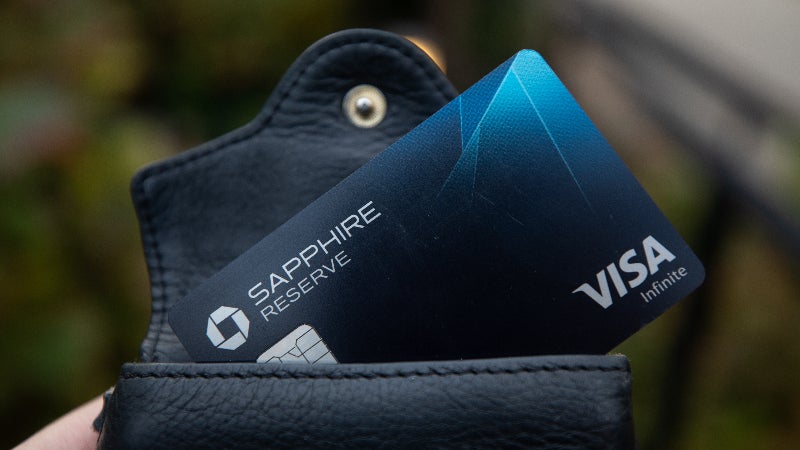Key takeaways
- The Chase Sapphire Reserve® is one of the best premium travel cards on the market, offering a host of valuable benefits and perks.
- This card earns up to 10X points on purchases, which can be redeemed for flights, hotel stays or transferred to Chase travel partners for even more value.
- The Sapphire Reserve provides users with a $300 annual travel credit and a variety of other benefits, including complimentary airport lounge access, various travel insurance benefits and more.
- Although the card charges a relatively high annual fee, the Sapphire Reserve benefits often make this card worth it for avid travelers.
The Chase Sapphire Reserve® comes with a $550 annual fee, which is higher than what many other rewards credit cards charge. However, if you’re often on the go and interested in benefits geared toward travel, the Sapphire Reserve can be well worth the cost.
Read on to learn about the Sapphire Reserve’s benefits and see how much value you can get from this travel credit card.
Chase Sapphire Reserve card details and benefits
Charging purchases to the Sapphire Reserve is rewarded with points, which are typically each worth 1 cent when redeemed for cash or 50 percent more when redeemed for travel through the Chase Ultimate Rewards portal.
As a cardholder, you earn:
Cardholder earnings
- 10X total points on Chase Dining purchases made through Ultimate Rewards
- 10X total points on hotel stays and rental cars through Ultimate Rewards
- 10X total points on Lyft purchases (through March 2025)
- 5X total points on airfare paid through Ultimate Rewards (after first earning your $300 travel credit)
- 3X points on general travel (after first earning your $300 travel credit) and restaurant purchases
- 1X points on all other purchases
Score $750 in travel
The Sapphire Reserve offers an enticing welcome offer of 60,000 Chase Ultimate Rewards points when you spend $4,000 within the first 3 months of opening your account. If you use those bonus points to book a flight, hotel room, cruise, rental car or other travel experience through Chase Ultimate Rewards, your points will be worth $900.
You also have the option to transfer points at a 1:1 ratio to any of the 14 hotel and airline loyalty programs Chase partners with — including Southwest Rapid Rewards, United MileagePlus, Marriott Bonvoy and World of Hyatt. If one of those programs is offering a deal on a seat or room you want, transferring your points and booking directly through that company might make your rewards go even further.
$300 travel credit
Each year, purchases in the travel category are rewarded with statement credits up to a total of $300 annually. This is more generous than the travel credits offered by some other travel cards, such as the up to $200 in incidental airline fee credits offered by The Platinum Card® from American Express (which can only be applied to purchases with one airline per year) or the up to $100 in airline incidental statement credits offered by the Bank of America® Premium Rewards® credit card.
While those cards apply their travel credits to only a few specific expenses like baggage fees and seat upgrades, the Sapphire Reserve automatically awards its credit on any purchase coded as travel — whether that’s airfare, accommodations or a rental car. Thus, you can snag this credit without having to give it much thought.
Airport lounge access
The Sapphire Reserve offers Priority Pass Select membership, which gets you access to over 1,500 airport lounges and experiences around the globe. A primary cardholder and any authorized users can each bring up to 2 guests with them. You can also get additional guests admitted for $27 per guest, per visit to a lounge.
Keep in mind:
The amenities offered at lounges vary, but perks often include free food and beverages, Wi-Fi, mobile device charging, conference rooms and showers.
You could gain access to Priority Pass lounges without a participating credit card by joining directly at the Prestige membership level, which grants unlimited free visits for members with an annual fee of $469. Considering the cost of a standalone membership, getting admittance with your credit card is a pretty sweet benefit.
Global Entry or TSA PreCheck Fee Credit
The Chase Sapphire Reserve offers a statement credit of up to $100 for either a TSA PreCheck application fee or a Global Entry application fee. You can claim this benefit once every 4 years, giving you plenty of time to renew your membership before the 5-year expiration date for either program.
Global Entry membership gets you through customs screening faster when returning to the U.S. from a trip abroad, while TSA PreCheck lets you go through a shorter security screening line when starting your journey from a U.S. airport. Global Entry members automatically get TSA PreCheck benefits, so if you travel internationally, you’ll likely want to use your credit to apply for Global Entry.
Primary rental car insurance and travel insurance
The Sapphire Reserve provides several insurance benefits, including baggage delay insurance and trip cancellation insurance. It offers primary rental car insurance that protects you against up to $75,000 in damages from theft or collision.
Complimentary DashPass
The Sapphire Reserve gets you a free DashPass subscription for a minimum of 1 year when you activate it by December 31, 2024. This includes unlimited free deliveries on DoorDash orders that meet the minimum purchase requirement.
The DashPass subscription alone costs $9.99 a month without this promotion, so this can be a worthwhile benefit if you regularly order takeout.
One year of complimentary Lyft Pink membership
Another Sapphire Reserve benefit is a complimentary Lyft Pink All Access membership that is good for 2 years if you activate by December 31, 2024. That gets you up to 10 percent off rides, free priority pickup upgrades and a free Grubhub+ membership for 1 year. A Lyft Pink membership costs $199 a year if you pay for it out-of-pocket.
On top of that savings, charging Lyft rides to your card through March 31, 2025, earns 10X points. Thus, buying a $25 Lyft ride would net you 250 Chase Ultimate Rewards points.
10X Points on qualifying Peloton purchases
This isn’t the most lucrative Chase Sapphire Reserve benefit, but cardholders can also earn 10X points on up to $5,000 in Peloton equipment and accessory purchases of $150 or more. The promotion expires March 31, 2025.
Bankrate’s take:
Although this benefit won’t help everybody, if you plan to purchase Peloton equipment anyway, it is an easy way to earn up to 50,000 points.
How does the Chase Sapphire Reserve compare to other premium travel cards?
The Sapphire Reserve provides a ton of valuable benefits for cardholders, but it isn’t the only travel card on the market. If you’re wondering whether you should get the Chase Sapphire Reserve, it makes sense to compare it to other premium travel cards before making your decision.
The Platinum Card from American Express is a solid alternative to the Chase Sapphire Reserve. This card comes with a welcome offer of 80,000 points after you spend $8,000 during the first 6 months you have the card. The Platinum Card also earns 5X points on flights booked directly with airlines, and it comes with a number of different benefits — including elite status through Marriott Bonvoy and Hilton Honors, complimentary airport lounge access, up to $1,700 in various annual credits and more.
The $695 annual fee is higher than the Sapphire Reserve’s, although it is easily offset by many of the card’s perks and credits. Keep in mind, however, many of the Platinum Card’s annual credits are restricted to specific merchants and can be difficult for some cardholders to use.
On the other hand, the Capital One Venture X Rewards Credit Card comes with a $395 annual fee and a bevy of benefits — including a $300 annual travel statement credit, up to $100 in statement credits toward TSA PreCheck or Global Entry and more. The Capital One Venture X also earns 10X miles on hotel and rental cars booked through Capital One Travel, 5X miles on flights booked through their travel portal and 2X miles on all other purchases.
To top it off, you can earn 75,000 bonus miles (worth $750 in travel) when you spend $4,000 in purchases during the first 3 months. The annual fee of $395 is less than both the Sapphire Reserve and the Amex Platinum, which makes it a card you should definitely consider.
Is the Chase Sapphire Reserve worth its annual fee?
If you’re frequently on the move and intend to take full advantage of the Sapphire Reserve’s travel benefits, this card can easily pay for itself. The $300 travel credit, Priority Pass Select membership (worth $469) and up to $100 in statement credits toward a Global Entry or TSA PreCheck application together more than cover the $550 fee. And when you consider the Lyft Pink, DoorDash and Peloton benefits, plus the substantial welcome offer, the Sapphire Reserve provides a lot of value.
How to offset the Chase Sapphire Reserve’s annual fee
If you’re on the fence about whether the Chase Sapphire Reserve is worth it, you may want to do the math to see whether your typical yearly spending will generate sufficient rewards to offset the annual fee.
During the first year, offsetting the Chase Sapphire Reserve annual fee is easy. Simply use your card to make $4,000 in purchases within the first 3 months, and you’ll earn a welcome bonus of 60,000 points. Those points are worth up to $900 in travel when you book through Chase Ultimate Rewards. Any points you earn on top of the welcome bonus are gravy, which easily makes the Chase Sapphire Reserve worth it during the first year.
Moving forward, let’s say you spend $3,500 on travel with your card. You earn the $300 statement credit, and the remaining $3,200 earns 3X points for a total of 9,600 points. Next, suppose you spend $900 to book a hotel stay through the Ultimate Rewards portal, gaining 10X points and adding 9,000 points to your total earnings. You also spend $1,800 at restaurants, netting you 5,400 points, and you make $1,000 in non-category purchases for an additional 1,000 points. Overall, you accumulate 25,000 points.
Redeeming those points for cash at the rate of 1 cent per point gets you $250 (which together with the $300 travel credit covers the $550 fee). Even better, redeeming those points for travel through Chase Ultimate Rewards makes them worth as much as $375. The best redemption of all, however, may be by transferring your points to one of Chase’s travel partners. According to Bankrate’s points and miles valuations, transfers are typically worth 2 cents per point — which makes your points worth as much as $500.
In this scenario, you offset the annual fee by spending $7,200 throughout the year, or an average of $600 per month. You could cover the fee even faster if you dedicate a larger portion of your spending to travel or restaurants. You could also book more travel, hotel stays or dining through the Ultimate Rewards portal to earn points quickly.
When the Chase Sapphire Reserve isn’t worth it
The Chase Sapphire Reserve’s annual fee probably won’t be worth it if you don’t spend at least $300 a year on travel. You won’t get the annual travel credit, and it may be challenging to earn enough points in non-travel categories to offset the $550 fee.
Additionally, the Sapphire Reserve likely isn’t the right card for you if you want to transfer a balance or don’t pay your credit card bill in full each month. The Sapphire Reserve doesn’t offer an introductory 0 percent APR on balance transfers. And if you tend to carry a balance, the interest you’d owe will probably add up faster than any rewards you might earn.
If the Sapphire Reserve’s travel benefits appeal to you but you’re reluctant to spend $550 upfront, you might want to apply for a different travel rewards card with a lower fee. For example, the Chase Sapphire Preferred® Card offers 5X points on travel purchased through the Ultimate Rewards portal, 2X points on travel purchased elsewhere and 3X points on dining, select streaming services and online grocery purchases (excluding Walmart, Target and wholesale clubs). With an annual fee of $95, it’s a more affordable option.
The bottom line
Determining whether you should get the Chase Sapphire Reserve comes down to completing a fairly simple cost-benefit analysis. The card comes with a relatively high annual fee, but its extensive travel benefits can more than make up for the cost if you’re an avid traveler. If you don’t travel frequently enough to justify paying $550 for the Sapphire Reserve’s perks, you might prefer a travel card with a lower fee or a rewards credit card with a different focus — such as a cash back card.
Read the full article here

















